Best Multimeters in 2024 – Buyer’s Guide, Reviews and Comparison
Multimeter Categories You Can Choose From
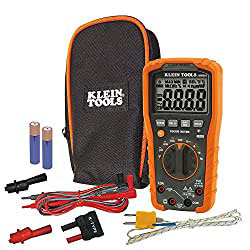
Multimeters Under $100
Delivering enhanced capabilities over their budget counterparts, these digital testers include additional specific functions — such as diode and capacitance measurement. Targeting the electronic enthusiast rather than the casual user — they can be recalibrated, therefore providing years of use.
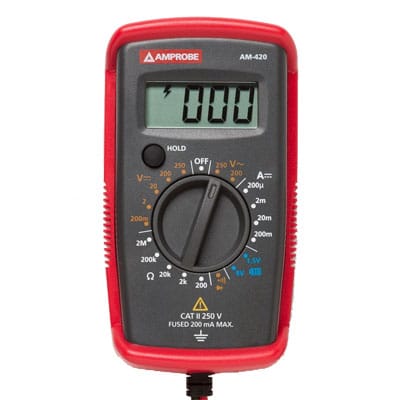
Best Multimeters Under $50
Excellent for your home toolbox or cupboard, these price-friendly multimeters are ideal for general household use or the casual DIYer. The best multimeter for the money can tackle anything from checking battery charge through to identifying short circuits.
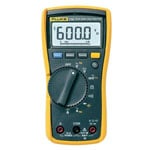
Best Automotive Multimeters
While the best electrical multimeter will test some vehicle circuits, they’re insufficient for pure car nuts. Targeted toward the serious automotive enthusiast, these units feature car-specific functions — such as measuring timing, dwell signals, and RPM.
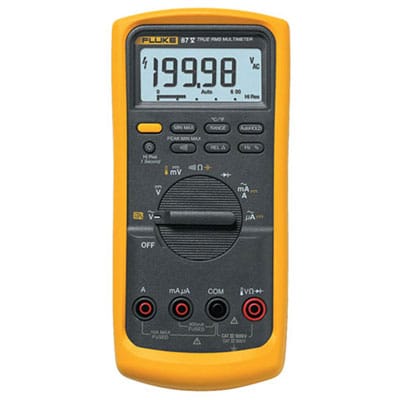
HVAC Multimeter Reviews
Aimed at heating, ventilation, and air-con engineers, these multimeters deliver functions that the general user will not require. Typically, the best meter for HVAC testing measures within one-tenth of an ohm, one-hundredth of an amp, and possesses at least a 600-volt rating.

Fluke Multimeters
Backed by over 70 years of experience in the manufacture of diagnostic equipment, this USA-based company offers a complete array of multimeters — from budget-friendly models through to specialized industrial measurement tools.
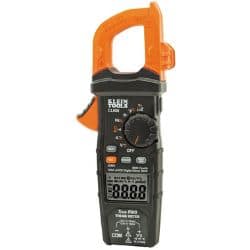
Clamp Meters
Allowing you to test circuits without stripping wires, clamp meters excel at investigating electricals without turning off the power. Basic machines can scrutinize voltage, current, and resistance — with pro-grade units tackling in-rush current, temperature, and ghost voltages.
Best Electric Meter From Each Category
| IMAGE | PRODUCT | DETAILS | ||
|---|---|---|---|---|
|
Best under $100 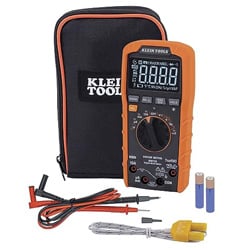
|
Best under $100
|
Klein Tools MM720
|
Features
|
Check Price at AmazonKlein Tools MM600 Review Klein Tools MM600 Review |
|
Best under $50 
|
Best under $50
|
Amprobe PK-110
|
Features
|
Check Price at AmazonAmprobe PK-110 Review Amprobe PK-110 Review |
|
Best Automotive Multimeter 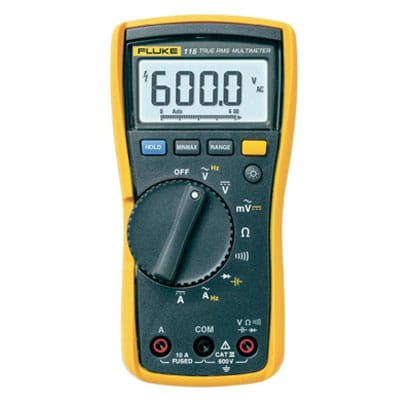
|
Best Automotive Multimeter
|
Fluke 115
|
Features
|
Check Price at AmazonFluke 115 Review Fluke 115 Review |
|
Best HVAC Multimeter 
|
Best HVAC Multimeter
|
Fluke 87-V
|
Features
|
Check Price at AmazonFluke 87-V Review Fluke 87-V Review |
|
Best Fluke Multimeter 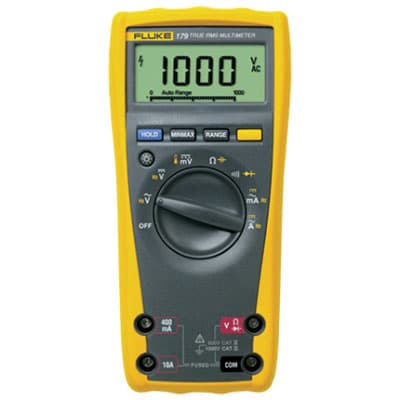
|
Best Fluke Multimeter
|
Fluke 179
|
Features
|
Check Price at AmazonFluke 179 Review Fluke 179 Review |
|
Best Clamp Meter 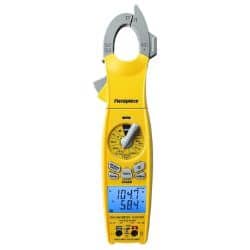
|
Best Clamp Meter
|
Fieldpiece SC680
|
Features
|
Check Price at AmazonFluke 179 Review Fieldpiece SC680 Review |
Best Multimeters Buying Guide
Multimeters are crucial tools for every serious DIYer, electronic hobbyist, automotive nut, and trade pro. Able to test batteries and circuits, troubleshoot faulty equipment, investigate safe operation, and examine electrical efficiency — the best multi tester machines have a plethora of uses.
These modern digital units offer more capabilities and greater accuracy than their analog cousins. The most basic models deliver information on voltage, frequency, current, and resistance — while more advanced tools can examine temperature, in-rush amps, and motor RPMs.
With straightforward operation, inclusion of numerous safety features, and optional auto-ranging — digital multimeters are as suited to the casual home user as they are to the trade professional.
When selecting your ideal unit, consider:
Resolution.
Multimeter Basics — Everything You Need To Know
Many people consider these units complicated and too complex to handle. However, don’t let the fancy knobs and buttons fool you, they’re pretty simple devices.
Once you use one a few times, you’ll get the hang of it quickly. All you have to know is how to take care of your personal safety, and that’s it. The definition of a digital multimeter is straightforward — it’s a tool that combines multiple testing features, such as a voltmeter, ohmmeter, and ammeter.
The Terminology — AC and DC
DC stands for direct current, in which electricity travels in only one direction. This type of current is mainly used in devices that run on batteries. For example, the electronics in your car run on DC.
A multimeter can measure both DC and AC currents.
Multimeter Symbols
There are many types of multimeters on the market nowadays — the price can range from $10 to several hundred dollars. Most of these meters have, at minimum, five primary measuring functions — selected by turning the dial to one of the numerous multimeter symbols.
- Voltage — AC or DC.
- Resistance.
- Current.
- Continuity.
- Frequency.
Multimeter Advanced Features
More advanced features, that may only be found in high-end meters, can include a graphical display to show AC measurements in real-time. This can be used for identifying irregularities in the wave signal.
Some units may also include a low pass filter, which is used for troubleshooting motor drives. A low impedance mode prevents ghost voltages from being measured, which allows more accurate measurements and precise readings.
Last, but not least, some advanced meters may include an offset compensation feature (Smart Ohm) which also offers better accuracy under certain conditions. This feature tests resistance with two different currents applied to determine if there are any offset voltages in the input circuit.
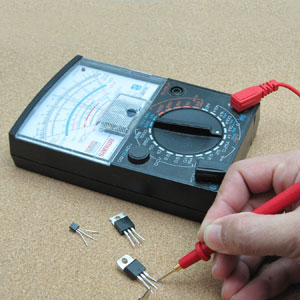
Analog and Digital Multimeters — What’s the Difference?
Digital Multimeter
A digital multimeter — also known as a DMM — is a tool traditionally used by technicians in the electrical industry, to measure different values, such as current, resistance, and voltage. These units replaced analog models and brought a whole new aspect of accuracy and precision to testing.
They combine a plethora of testing capabilities in one device — instead of having the hassle of using the best voltage meter, current meter, and frequency monitor separately.
A digital multimeter face typically has four components — an LCD screen, selector buttons, a rotary dial for determining the measurement values (voltage, amps, and ohms), and two sockets for the testing probe jacks. These investigative cables attach to the unit — acting as a conduit between the meter and the component/circuit being tested.
Modern DMMs have grown and evolved significantly, in relation to sensitivity and precision, since they were launched on the market. As the demand for accuracy grows, it makes much more sense to use a digital meter instead of an analog model.
Most of the newer DMMs deliver remarkable versatility. For example, you can set the range either manually or automatically — it’s up to you. An auto-range feature saves a lot of time and hassle because you don’t have to know the actual range yourself — the unit does that for you.
Analog Multimeter
Although digital multimeters are taking over the market, analog devices can still be relevant and useful. The first difference between these two types is the way they deliver readings — analog multimeters have a needle that swings across the calibrated scale, whereas the digital model has an LED display.
One of the advantages of analog is that they deliver results much quicker than digital. The lack of delay particularly helps electricians who are checking the continuity of several wires at once. Those who want to measure transitory voltage will also appreciate the instantaneous readings.
Also, analog devices don’t suffer faults as often as their digital counterparts. Due to the lack of sensitive electronics, analog multimeters offer reliability and — most importantly — consistency and precision.
Yet, because an analog meter has a needle and coil to represent its readings, it can be very sensitive and delicate to vibrational shocks. So, whereas digital meters can take a few bumps and hits, analogs can’t — which can lead to either them going out of calibration or completely damaging the coil and the needle.
However, you can alleviate the issue by protecting the device in a plastic or rubber casing, although it’s just a preventive measure and doesn’t guarantee absolute resistance and immunity to physical damage.
As far as readability goes, digital multimeters are far simpler. The display on an analog meter consists of a variety of scales with different values. If you don’t know the proper way to read the values, it will be difficult to use the meter. With digital meters, it’s quite easy, as you get a number displayed as well as the measurement units.
The lack of decimals is also a common problem for analog units. It can be quite challenging to determine the below-zero values on an analog device.
What To Consider When Buying Multimeters
Our multimeter reviews include only the pinnacle of electrical testing units. However, while our top machines represent the best tools on the market — different units are more suited for specific projects and user preferences.
Here are some factors to consider when purchasing a reliable and good multimeter:

Resolution
Units with greater resolution detect the smaller changes in input signals. The resolution of a DMM is expressed by the number of digits it’s able to display. Most units on the market are either 3.5 or 4.5-digit meters, with the range of 1999 to 19999. The resolution is sometimes specified as the count.
Whether you’re an amateur or professional, you’re going to need a device with a good resolution, to tackle some of the more sensitive projects.

Accuracy
Needless to say, a unit with high accuracy offers more exact readings — however, you don’t have to purchase the most precise unit on the market. If your needs are just basic testing of voltage and continuity — a high level of accuracy isn’t required.

Root Mean Squared (RMS) and True Root Mean Squared (TRMS)
Digital multimeters either perform tests through RMS or TRMS systems. Effectively, Root Mean Squared systems only check sinusoidal waves — whereas True Root Mean Squared units also measure non-sinusoidal waves.
In real terms, TRMS is more accurate than RMS.
If your projects include working with microchips or VFD (variable frequency drive) motors — you need the precision of a TRMS multimeter. If not, go for a more affordable RMS tool.
If you’re interested — here’s the technical stuff behind how RMS and TRMS work.

Auto-Ranging
Automatically, they select the perfect range for the circuit or component being scrutinized. For example, if you’re checking a resistor — the unit will decide whether you receive the feedback in milliohms, ohms, kilo-ohms, or megohms.
This has the benefits of:
- Delivering the greatest accuracy.
- Allowing novices to use a multimeter.
- Saving time twiddling with dials.
- Ensuring your multimeter is protected from surges.

Additional Testing Capabilities
Our Digital Multimeters Review From Each Category
Klein Tools MM720
Best Multimeter Under $100
Our Rating: 4.6
Targeting the light contractor and dedicated home enthusiast — the Klein Tools MM720, with its 1000-volt testing capacity and temperature indicator, is ideal for business, residential, and industrial applications.
Robustness is at the heart of this unit, with a rubberized outer shell providing reassuring durability to withstand those accidental knocks — the manufacturer states it can endure a 6.6-foot drop — invaluable for the hardcore or frequent user.
Impressively versatile, this machine can measure temperature, low-impedance, frequency, capacitance, and test resistance to 10 amperes. Furthermore, it boasts a low-battery indicator and an easily accessible fuse and battery compartment — permitting rapid replacement and reducing downtime.
And, if that wasn’t enough, this multimeter arrives complete with a carry case, clips, testing leads, pouch, and batteries.
- Design
- Functionality
- Price
Our Rating: 4.3
If you’re a hobbyist who needs a decent machine for occasional voltage and current tests, check out our budget top rated multimeter — the Amprobe PK-110 kit.
Although it’s not really suitable for professionals, due to the lack of functions, it’s great for DIYers because of its versatility and ease of use.
The thing that makes the Amprobe PK-110 different from other units on the list is the fact that this is a kit rather than a single unit.
The set includes an AM-420 multimeter, VP1000B non-contact voltage stick, and ST102B socket tester. All three of these components are equally useful in various situations. The only minor shortcoming is that it can only measure voltages up to 250 volts.
- Design
- Functionality
- Price
Our Rating: 4.8
It’s compact, lightweight, and easy to use — those three factors make this particular product attractive from the start. It has a large display, which doesn’t lose contrast at different angles. The LED backlight ensures crystal-clear test results, so that you can see what you’re doing, even in dimly-lit locations.
One of the best points about the Fluke 115 is its portability. Due to its compactness, it’s suitable for fieldwork and rough conditions. It can be used both by DIY enthusiasts and professionals, thanks to its versatility, precision, and accuracy.
- Design
- Functionality
- Price
Our Rating: 4.7
One thing you’ll notice right away is the price. Although many people expect high-end multimeters to be quite expensive, it isn’t necessarily the case. For example, this unit comes with an affordable price tag, yet it offers most of the features you might need during tests and diagnosis.
It can measure up to 10A and 20A in 30 seconds, without an issue. The True RMS offers accurate data every time, and other functions, such as the data hold feature, will ease the use of this already simple-to-operate product.
- Design
- Functionality
- Price
Our Rating: 4.8
Auto-ranging ensures novices are always using the correct metric — while pros can switch to manual mode for bespoke results. Measuring temperatures up to 752 degrees Fahrenheit — it’s suited for both automotive and HVAC applications.
Its generous backlit display permits effortless reading of investigations — even in poorly-lit environments. And, in addition to the expected numeric readout, it also delivers results as an analog bar graph.
- Design
- Functionality
- Price
Focusing on the HVAC market, its clamp makes it a non-wirecutter multimeter — allowing you to investigate circuits with the target power switched on. What’s more, an integrated low-filter removes electrical noise.
CAT IV-rated, the Fieldpiece offers non-contact voltage warnings — elevating user safety. And, with dual temperature testing, you can investigate both input and output heat levels on HVAC equipment.
- Design
- Functionality
- Price
Multimeter Safety
However, even if you’re a long-time professional, it’s always wise to take precautionary measures before dealing with electricity.
The things you should do:
Discharge the circuit before connecting a multimeter.
Don’t apply power while measuring resistance.
Make sure your meter is set on AC mode before you start measuring AC current.
Pay attention to polarity when handling DC.
When you’re done using it, switch the device off — if there’s an OFF button. If not, set the meter to the highest AC voltage.
Do not touch an open circuit with bare hands, regardless of voltage values.
For more information, check out my article on the Safe Use of a Multimeter.
Conclusion
For trade pros, motor vehicle fanatics, DIYers, and homeowners — a digital multimeter is an essential tool.
Whether you’re checking the charge in a battery, tuning a vehicle engine, or diagnosing HVAC faults — a versatile multimeter can save you time and money.
When choosing your machine, first consider the accuracy you require — and therefore, if you need a TRMS or RMS unit. Secondly, do you need the convenience and foolproof-focused auto-ranging machine, or is a manual multimeter sufficient?
Finally, think about the projects you’ll be using the tool for — and correspondingly the features you require. Consider if it’s important your machine can measure temperature, RPM, or current surge.
Whatever your particular needs — check out our best multimeters above for the ultimate in electrical testing ability.
Best Multimeters FAQs
Q: What Multimeter Is Best for Checking Air Conditioning?
For HVAC projects, ensure you select a multimeter that features:
- Minimum 600-volt rating.
- Microamp testing.
- Flame sensor compatibility.
- Drop-proof casing — as most work will be conducted off the ground.
Q: What Is Best — Volt Meter or Multimeter?
Even the best voltmeter can’t come close to the versatility of a digital multimeter. In addition to matching a voltmeter’s AC and DC testing abilities, even the most basic multimeters can also investigate frequency, continuance, resistance, and current.
Q: What Is the Best Multimeter in Australia, America, and Europe?
The best multimeter is always the machine that’s most suited for your project requirements. Many casual users and DIYers need nothing more than a budget unit, others may demand the performance of an automotive or HVAC machine.
Check out our digital multimeter reviews above to help select the perfect tool.
Q: Digital Multimeters Reviews Mention TRMS — What Is It?
Read any multimeter review, and you will see RMS and TRMS mentioned.
Standing for Root Mean Squared and True Root Mean Squared respectively, these terms explain how circuit current and voltage are analyzed by the multimeter. In all circumstances, TRMS is more accurate.
For an in-depth explanation of how TRMS and RMS work, check out my TRMS vs RMS guide.
Q: Can a Multimeter Start a Dead Car Battery?
No. While a multimeter can check the current and voltage of your motor’s power cell, it cannot spark it back to life. Instead, you need a jump starter.

